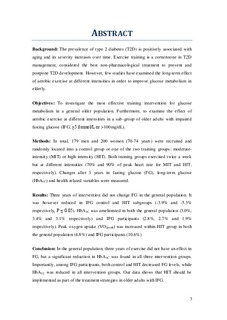| dc.description.abstract | Background: The prevalence of type 2 diabetes (T2D) is positively associated with aging and its severity increases over time. Exercise training is a cornerstone in T2D management, considered the best non-pharmacological treatment to prevent and postpone T2D development. However, few studies have examined the long-term effect of aerobic exercise at different intensities in order to improve glucose metabolism in elderly.
Objectives: To investigate the most effective training intervention for glucose metabolism in a general older population. Furthermore, to examine the effect of aerobic exercise at different intensities in a sub-group of older adults with impaired fasting glucose (IFG, ≥5.6mmol/L or >100mg/dL).
Methods: In total, 179 men and 200 women (70-74 years) were recruited and randomly located into a control group or one of the two training groups: moderate-intensity (MIT) or high-intensity (HIT). Both training groups exercised twice a week but at different intensities (70% and 90% of peak heart rate for MIT and HIT, respectively). Changes after 3 years in fasting glucose (FG), long-term glucose (HbA1C) and health-related variables were measured.
Results: Three years of intervention did not change FG in the general population. It was however reduced in IFG control and HIT subgroups (-3.9% and -5.3% respectively, P ≤ 0.05). HbA1C was ameliorated in both the general population (3.0%, 3.4% and 3.1% respectively) and IFG participants (2.8%, 2.7% and 1.9% respectively). Peak oxygen uptake (VO2peak) was increased within-HIT group in both the general population (4.8%) and IFG participants (10.6%)
Conclusion: In the general population, three years of exercise did not have an effect in FG, but a significant reduction in HbA1C was found in all three intervention groups. Importantly, among IFG participants, both control and HIT decreased FG levels, while HbA1C was reduced in all intervention groups. Our data shows that HIT should be implemented as part of the treatment strategies in older adults with IFG. | nb_NO |
